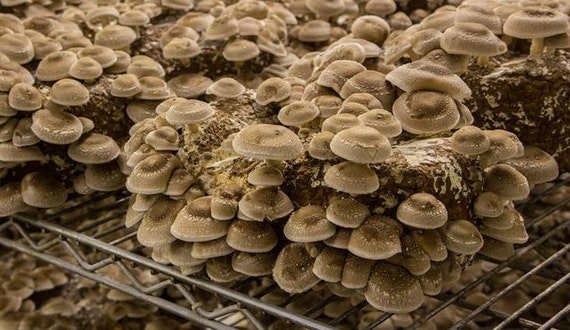 |
| Shiitake |
Growing
Today we set up a Shiitake mushroom growing kit. We got the block on Sunday at the market for $10 and hopefully we can get some growing mushrooms in the next few days!
The "block" is a compressed block of red alder sawdust, organic rye grain, spring water, and Shiitake mushroom culture. The kit was sold to us by Sno-Valley Mushrooms.
If you will not grow your mushroom immediately, please put your mushrooms in the refrigerator. If this is not done, your kit will start growing mushrooms prematurely.
 |
| Shiitake mushroom growing kits |
Step 1
Remove bag and rinse kit thoroughly in tap; clean away any yucky stuff. After cleaning, flip kit upside down (you should see two parallel indents at the top). Keep kit at room temperature.
After misting with de-chlorinated water, (rain water ideal, if you put out water for the chlorine to evaporate not necessarily all of it will disappear because chloramines are being more frequently used in tap water) place a plastic bag (white bag ideal) over the mushrooms as a humidity tent. Remove shopping bag only to mist, rinse or harvest mushrooms from the kit. Rinse the kit daily with non-chlorinated water, but don't directly rinse growing mushrooms. Remember to keep your kit aerated, so put it ontop of a cooling rack.
Does Your Water Contain Chloramine?
Does Your Water Contain Chloramine?
 |
| Skeletal formula of chloramine |
 |
| Chloramine Model |
Step 2
Baby Shiitake mushrooms will come out in 3-4 days. After coming out, another few days will give them enough time to fully develop into harvestable mushrooms. After gills are exposed, harvest all mushrooms at the same time when the majority are full grown. If not eaten when harvest, store in refrigerator for up to two weeks.
 |
| Immature Shiitake mushrooms |
Step 3
After the first harvest, let your kit rest. Put in a warm room without its humidity tent so it can dry out for 14-21 days. Watch out for signs of mold, wash of any green mold under running water. After the resting period has passed, rinse the kit thoroughly and soak it in some water for 6-12 hours. Repeat Step 2 and hopefully you will get 2-4 harvests this way.
| A growing Shiitake mushroom kit |
Step 4
The kit will shrivel up and grow mold as the mushroom uses its energy. Before this happens, you can use various methods to transport the mushroom into a log where it can live out its life. Contact me.
Enjoy your mushrooms!